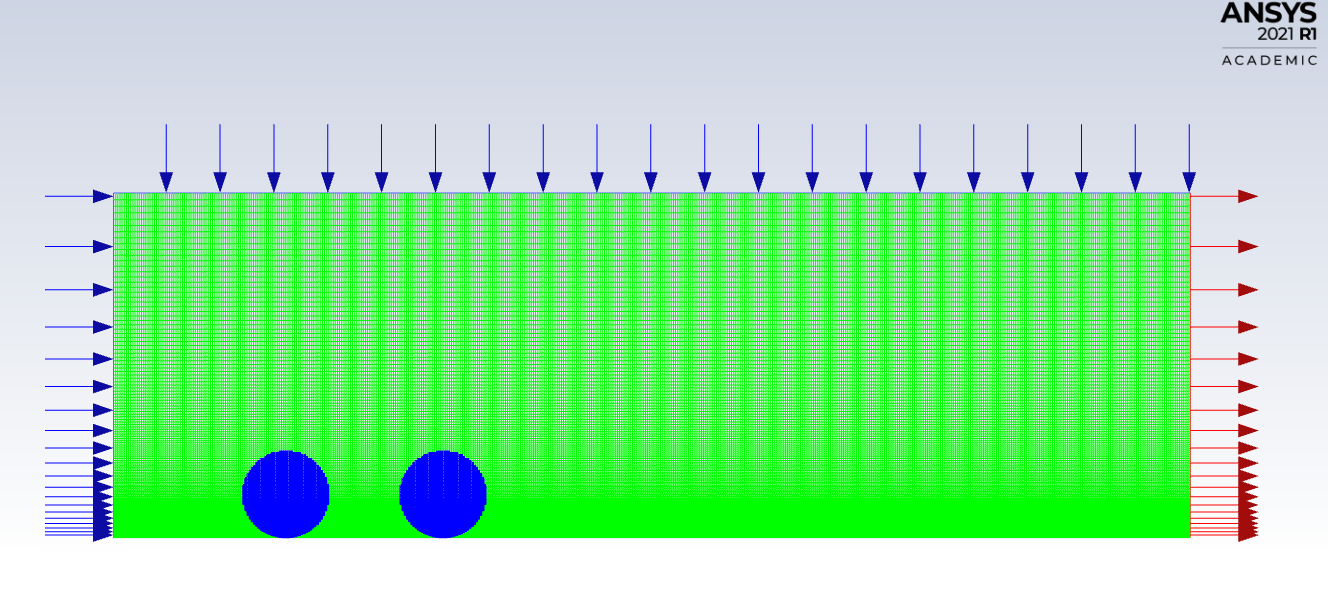TAGGED: droplets, hydrophobic, vof-model, vof-multiphase
-
-
December 14, 2021 at 7:38 am
Rusbel.Ayala
SubscriberGreetings,
I am looking to model two water droplets merging together into one droplet, over a hydrophobic surface. The primary phase being air and the secondary being water.
I am achieving the merging but the physics is a little off in that the first droplet detaches then merges into the second one. When I try to move the droplets up, gravity seems to not work. they simply flow in the x direction. Wall contact angle set to 155°, wall - no slip/stationary wall, Also initializing the problem from the inlet causes a numerical instability (the droplets disperse into the domain). But when all initialized values are 0, it creates the merging I am looking for. Is this appropriate? From the EdX FEA course I believed inlet initialization was best.
Here are the current settings I am seeing some success with.
- Model: VOF, gravity on, transient
- implicit, sharp interface model, surface tension =0.072
- Viscous Model: K-Omega SST, Low-re correction on, constants: default, production limiter on
- scheme: Fractional Step
- gradient: Least square cell based
- pressure: PRESTO!
- momentum: 2nd upwind
- volume fraction: Compressive
- Turbulent kinetic energy: 2nd upwind
- specific dissipation rate: 2nd upwind
- Transient formulation: non-iterative, 2nd order implicit
Droplets created using cell registration - patched in initialization. Volume fraction of each drop = 1.
My goal is to simply have some appropriate physics before moving on to finer mesh and 3d implementation. Is the Eulerian VOF a better method to implement here?
Any and all help would be appreciated, apologies if not located under the proper category/thread.
Thanks
December 17, 2021 at 2:25 pmRob
Forum ModeratorCheck if the flow really is turbulent - I don' t know the scale so can't comment. Turn off NITA and ensure you converge the solution for each time step. VOF is the correct choice, but you need to be careful with the initial conditions: I don' know what has been set but if it's not correct (ie turbulence is high) the droplets may do something odd. Due to the way the VOF model works as soon as the droplets touch they'll try and form one large droplet.
January 1, 2022 at 2:05 amRusbel.Ayala
SubscriberThank you for the recommendations. The scale of the droplets are 2 mm in diameter, with the domain size of 25 mm x 8 mm. Current mesh Element Size: 5e-5. With finer mesh towards the wall. This gives about 40 cells per diameter.
I am currently using VOF + LES smagorinsky-Lilly, the first droplet detaches and hits the second droplet - then merging much like the picture above.
The current speed of the inlet is 5 m/s.
The droplets are on a hydrophobic surface I set the boundary condition - wall - wall adhesion 155┬░
Phase interaction surface tension coefficient 0.072 (air/water coeff.)
Can you go into further detail on setting initial conditions.
I am initializing with all values as 0, Localized turbulent initialization: On, relative to cell zone. However still not getting the desired physics.
January 3, 2022 at 5:40 pmRob
Forum ModeratorWith 5m/s into a static system the first droplet will move first as the velocity field will build from the inlet. As the droplets enter the same cell(s) they'll connect and give the result you're seeing.
Viewing 3 reply threads- The topic ‘Tracking water droplets over Hydrophobic surface – 2 phase VOF’ is closed to new replies.
Ansys Innovation SpaceTrending discussionsTop Contributors-
3597
-
1283
-
1117
-
1068
-
983
Top Rated Tags© 2025 Copyright ANSYS, Inc. All rights reserved.
Ansys does not support the usage of unauthorized Ansys software. Please visit www.ansys.com to obtain an official distribution. - Model: VOF, gravity on, transient
-












